We hope that each of you, our readers, will enjoy and appreciate this article we present about these 3 Amazing Birds of Asia. It was certainly our great pleasure to compile the information for you. May it provide you with both education and increased awareness.
Certainly, however, the few species listed herein represent only a portion of the remarkable avians found in the region. It’s our belief, though, that they serve as excellent examples of the wonders found here. Check out some of our other articles for similar marvels.
Nicobar Pigeon
Nicobar Pigeon Facts
- Leading off this article about 3 Amazing Birds of Asia we present to you the remarkably colored animal known as the Nicobar Pigeon.
- Perhaps most notably, the term applied to uit serves as the generally accepted common name of a highly distinctive species of pigeon. This truly amazing bird remains better known to researchers by its scientific name, however.
- That, somewhat unfortunately, is the comparatively difficult to pronounce term of the Caloenas nicobarica. Regardless of which of these names one uses to refer to it, though, the animal represents a legitimate wonder of Nature.
- This occurs partly due to one impressive statistic that’s not readily apparent. It constitutes the closest known remaining relative of two now extinct birds. More precisely, those birds were the Rodrigues solitaire, and the infamous dodo.
- The first known sighting of the remarkable bird by someone from outside of its native range only occurred in 1738. That’s because, at that time, the respected English naturalist Eleazar Albin made note of the distinctive animal.
- The first official recognition of the colorful Nicobar Pigeon as a distinct species, however, took place in 1758. At that time, the renowned Swedish naturalist Carl Linnaeus noted the fascinating bird in his updated Systema Naturae.
- In modern times, the IUCN now lists it as Near Threatened, on its Red List of Threatened Species. For the moment, though, the animal faces several threats. Its most pressing danger nonetheless likely comes in the form of ongoing climate change.
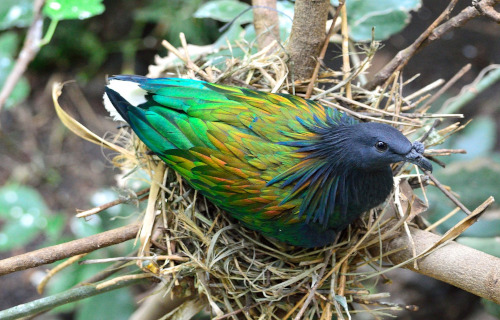
Nicobar Pigeon Physical Description
Obviously, the visually magnificent Nicobar Pigeon qualifies as an impressive form of pigeon. But, it does so for more than just its quite distinctive appearance. That holds true due to the fact that the bird also ranks as one of the larger known varieties of pigeon.
In addition to this, like many related creatures, it displays a moderate degree of the physiological trait of sexual dimorphism. In this specific case, however, that characteristic most notably manifests itself in terms of the sheer physical size of the creature.
That holds true because of the fact that males of the species attain a slightly greater average size than the females do. Nonetheless, an overall average mature adult of this stunning species attains a remarkable body length measuring approximately 16 in (40 cm).
Otherwise, both genders of the Nicobar Pigeon appear the same. The tails develops as short, and a white in color. The head appears gray, and the upper feathers change to a green and copper-like hue. The rest of the body typically presents varying shades of metallic green.
- Kingdom: Animalia
- Phylum: Chordata
- Class: Aves
- Order: Columbiformes
- Family: Columbidae
- Genus: Caloenis
- Species: C. nicobarica
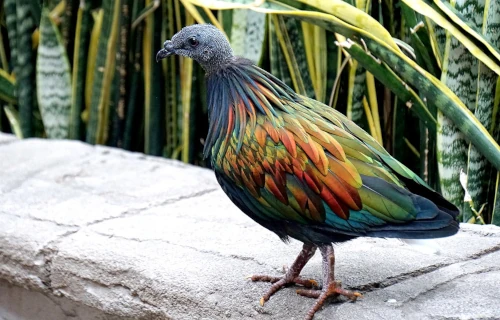
Nicobar Pigeon Distribution, Habitat, and Ecology
Quite unfortunately, the uniquely gorgeous bird known as the Nicobar Pigeon inhabits a relatively scattered range of the world. That holds true because, though its habitation range covers a reasonably moderate area, it only appears in isolated concentrations.
As its name implies, its greatest concentration appears in the Nicobar Islands, which forms a part of the country of India, in Asia. Other concentrations of its population also appear along mainland India, in the Malay Peninsula, the Solomon Islands, and Palau.
Given its range, its preferred habitat likely comes as no surprise. In point of fact, it appears almost exclusively in regions of tropical rainforest. Within this range, with the exception of those along the continental coast, the animal migrates from island to island.
The gorgeous Nicobar Pigeon evolved a diet similar to many, though not all, pigeons. In its specific case, the magnificent bird feeds primarily on a combination of fruit, buds, and seeds. The animal is also attracted to any area where grain is available.
Wilson’s Bird of Paradise
Wilson’s Bird of Paradise Facts
- The next creature making its appearance in this listing of 3 Amazing Birds of Asia is the astonishing animal named the Wilson’s Bird of Paradise.
- This mesmerizing avian, with the incredibly distinctive appearance, simply goes by the common name that we have used here. In fact, to the knowledge of scientists, the remarkable bird currently has no other generally accepted name.
- Among professionals, such as ornithologists, however, the animal’s most often referred to by its formal scientific name. Like many such technical terms, though, it’s hard to pronounce. That’s because that technical name is that of the Cicinnurus respublica.
- It’s name further holds a small note of historical notoriety and controversy. The notoriety’s because the French ornithologist who made the original recognition of it as a separate and distinct species was Charles Lucien Bonaparte, a nephew of Napoleon!
- Meanwhile, the controvery stems from his choice of scientific name. His choice of “respublica” represented an intentional affront to traditionalists in the field. That’s because their tradition was to dedicate any new species to a member of the monarchy.
- Sadly, the magnificent Wilson’s Bird-of-paradise finds itself in a precarious position in terms of its survival. That also appears to hold true throughout the entirety of its endemic range. The IUCN, therefore, now lists it as Near Threatened on its Red List.
- Habitat loss currently constitutes its most immediate threat. Yet it also faces seral other dnagers to its continued existence. It’s own limited range, and exploitation further endanger it. Its greatest potential threat, though, doubtless comes from climate change.
Wilson’s Bird-of-paradise Physical Description
It’s worth noting that the astonishing Wilson’s Bird-of-paradise garners full attention from those who encounter it wholly regardless of sheer physical size. That’s due to the fact that, in that particular category, it actually qualifies as a rather unimpressive species of bird.
Yet that’s perhaps the only category in which it fails to impress, at least in the minds of most. Those statistics, however, only serve to highlight how intriguing it is in other ways. Nature, it seems, often does its most impressive work while working with its smaller packages.
The truly amazing creature also manifests a certain degree of the physiological characteristic known as sexual dimorphism in regards to size, among others ways. In this specific instance, though, the size differences between the two genders remains exceedingly minor.
That’s partly due to the fact that both genders of the bird attain the same approximate average length. That measures roughly 6.3 in (16 cm). The males, however, attain a slightly greater average weight, measuring 53 – 67 g. females, meanwhile, only average 52 – 60 g.
It’s in appearance, though, that the sexes show the greatest degree of difference. The males display a combination of a red and black background. This, though, gets augmented by a light green on the mouth, a yellow neck, and blue feet, with two curled violet tail feathers.
The females of the awesome Wilson’s Bird-of-paradise, though, show markedly milder color schemes. In this respect, it also follows the familiar pattern among many related species. These typically present an overall brown color, with the presence of a bare blue crown.
- Kingdom: Animalia
- Phylum: Chordata
- Class: Aves
- Order: Passeriformes
- Family: Paradisaeidae
- Genus: Cicinnurus
- Species: C. respublica
Wilson’s Bird-of-paradise Distribution, Habitat, and Ecology
Not surprisingly, the stunning Wilson’s Bird-of-paradise inhabits a general section of the globe already well-known for its abundance of natural beauty. That’s because this marvel of Nature evolved as native to the overall portion of the world now known as Asia.
More specifically, it appears in parts of the country of Indonesia. Even there, however, this astounding product of evolution evolved as native to a highly restricted habitat range. This holds true since it only lives on the islands of Batanta and Waigeo, off West Papua.
Yet even within this already extraordinarily restricted zone of habitation, it displays traits which complicate its already arduous situation. This highly unusual species also displays extremely rigid requirements for its choice of locations in which to make its home.
Firstly, though unsurprisingly, it only lives in the rainforests of the region. Following that, however, it also only appears in the lowlands, or on hillsides. The majority of specimens further appear at around 984 ft (300 m), for unknown reasons, and rarely below that.
The Wilson’s Bird-of-paradise also remains a rarely seen species. Therefore, the first filming of it didn’t occur until Sir David Attenborough managed it in 1996. He did it by annoying a male specimen, interrupting its mating ritual of clearing a spot on the forest floor.
Like most avians, it also evolved as an omnivore. Its diet primarily consists of various local fruits, arthropods, insects, and other small invertebrates. Outside of the observed mating rituals, researchers still know very little about it otherwise, including its own predators.
Long Eared Owl
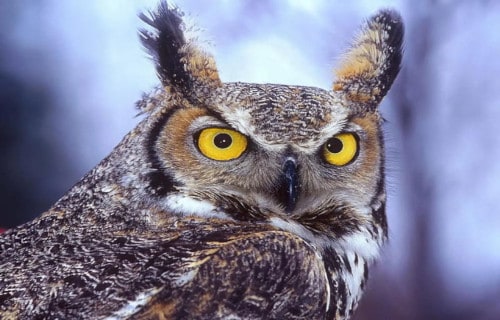
Long Eared Owl Facts
- Closing out this compilation of 3 Amazing Birds of Asia comes the breathtaking raptor whose name fits it perfectly, the Long Eared Owl.
- Perhaps most notably, the descriptive term for the bird serves as one of the common names for a truly majestic type of raptor. The animal does, however, also possess several other common names. These are used in various parts of its range.
- These alternate common names include several highly descriptive terms. They include such terms as the cat owl, the lesser horned owl, and the northern long-eared owl. This beautiful avian also goes by the scientific name of Asio otus, though.
- This gorgeous creature additionally shares a great portion of its native range with a related avian. That’s the visually quite similar species known as the short-eared owl. The two animal can most easily be distinguished while at rest.
- That’s because, at that time, the ear tufts of the Long Eared Owl become clearly visible. This constitutes the most easily recognizable physical difference between the two. In addition, the eyes of the two different creatures display different colors.
- A total of four recognized subspecies of this remarkable avian currently exist around the world. But, the Long Eared Owl has a decided advantage over many of them. Unlike some of them, this wonderful bird appears to have a sizable and stable population.
- Due to this, the IUCN presently lists it as a Species of Least Concern. This ranking appears on its Red List. It nonetheless must be considered to be facing at least a few threats to its existence. These would include habitat loss and climate change.
Long Eared Owl Physical Description
Firstly, the beautiful Long Eared Owl merits attention for other factors than merely its size. That holds true because the animal develops as an owl of medium physical size. Secondly, it does display a moderate of the characteristic of sexual dimorphism.
Individuals of this animal further attain a respectable body size. Mature specimens average roughly 16 in (40 cm) in total length. Meanwhile, wingspans average about 39 in (100 cm). Adult body weight varies significantly, but averages 15.3 oz (435 g).
The female of the stunning Long Eared Owl also grows larger and heavier than the male. These females also develops as darker in coloring. The prominent ear tufts of both sexes generally develop as black in color, though, and centered on the head.
The prominent feathers of the bird also possess a striking pattern of colors. These usually appear as a light brown in color, with vertical darker stripes present as well. The impressive eyes of this stunning species also typically grow comparatively large.
- Kingdom: Animalia
- Phylum: Chordata
- Class: Aves
- Order: Strigiformes
- Family: Strigidae
- Genus: Asio
- Species: A. otus
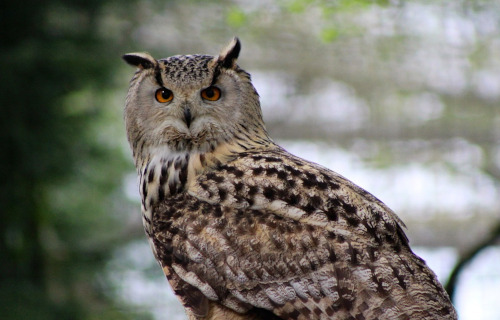
Long Eared Owl Distribution, Habitat, and Ecology
Much like many related species the Long Eared Owl evolved as partially migratory in nature. However, to the surprise of many people, this avian inhabits a relatively broad swathe of the globe. That’s due to the fact that it appears on three separate continents.
More precisely, however, it appears in a total of three separate continents. These consist of the continents of Asia, Europe, and North America. The fascinating animal commonly generally moves southward within its native range during the winter months.
The stunning raptor also has decided preferences for the type of region it chooses for its habitat. This holds true since individuals primarily inhabit forests that developed close to open areas. That further provides a combination of protective cover and good hunting.
Most individuals typically make nests in coniferous trees. Also, breeding occurs between February and July, and clutches average 4-6 eggs. The marvelous Long Eared Owl also shares one particular behavioral characteristic common to all owls.
That’s the fact that it generally hunts at night. Even among its kindred, this animal stands out for its skill as a hunter. The raptor remains renowned for being virtually silent while hunting. Its principal prey consists of a variety of small mammals, rodents, and other birds.
3 Amazing Birds of Asia
We greatly hope that each of you completely enjoyed reading, and hopefully learning from, this article we’ve presented about these 3 Amazing Birds of Asia. It’s also our hope that doing so has left you with either a new or renewed appreciation for such wonders of Nature.
Unfortunately, however, many of their kindred around the world now find themselves facing strong threats to their continued existence as a species. Many of those dangers, in fact, stem from the actions of mankind. We must do all we can to protect and preserve them all.
Check out our other articles on 7 Intriguing North American Invertebrates, Spectacular Halloween-Appropriate Species, 7 Breathtaking Canyons and Gorges
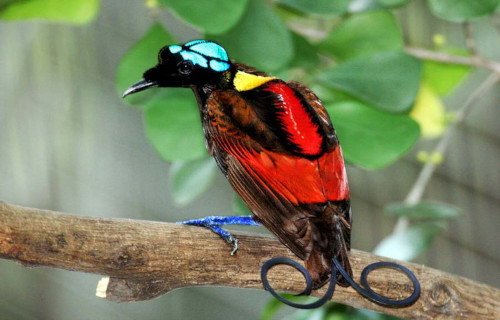
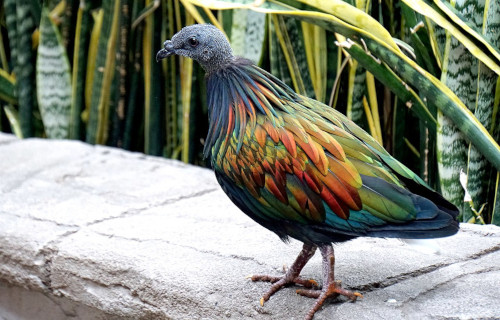
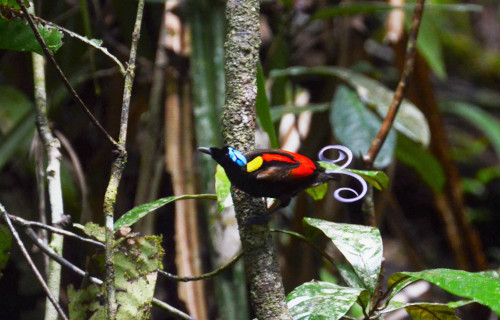
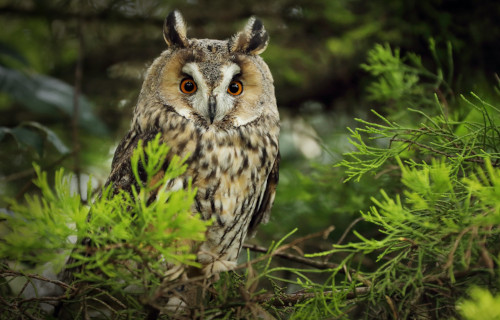









Leave a Reply